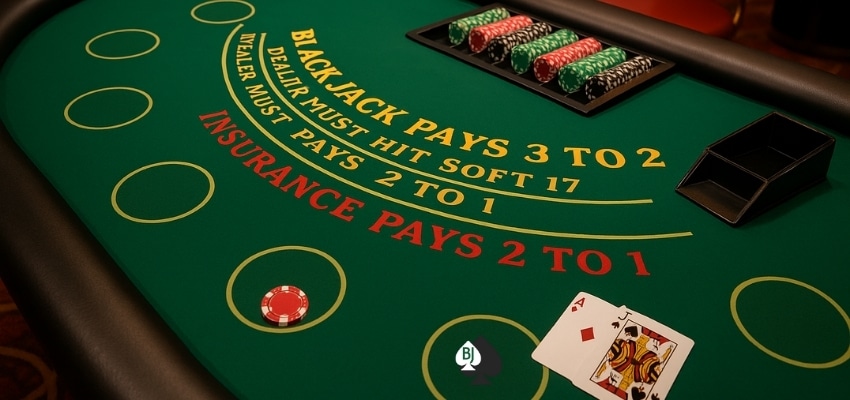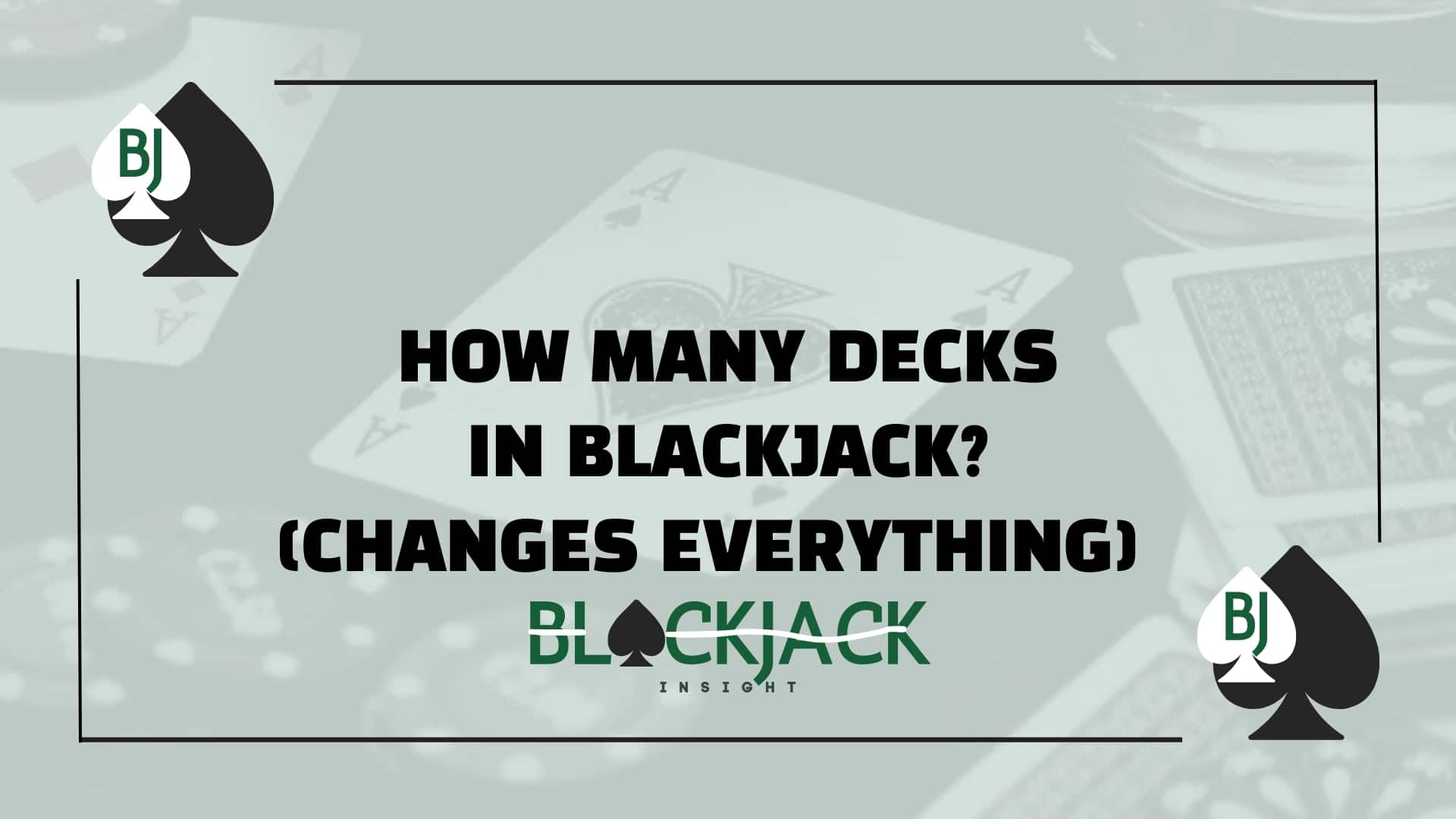How Many Decks in Blackjack? (Changes Everything)
Table Of Content
Blackjack is typically played with 1 to 8 decks of cards. Single-deck and double-deck games offer better odds for players but are increasingly rare and often come with less favorable rules. Most casino blackjack tables use 6 or 8 decks, which increase the house edge and make card counting more difficult. Fewer decks mean better odds, while more decks favor the casino. The number of decks also affects basic strategy and payout structure, making it a crucial detail for any serious player.
If you’ve ever wondered how many decks in blackjack are actually used at the tables — congrats, you’re already asking the kind of question smart players ask. And honestly? This is one of those little details that most beginners completely overlook. Big mistake.
Knowing how many decks of cards are used in blackjack doesn’t just help you understand the game better — it actually changes the strategy, the odds, and even your chances of winning. Seriously, the difference between a single-deck blackjack game and an 8-deck blackjack shoe is like night and day.
Let me break it all down for you — not like some dry rulebook would, but like a real player sitting next to you at the table would explain it.
A Brief History of Blackjack Decks
In its early days, Blackjack was played with just a single deck. Players could more easily keep track of the cards, which gave rise to card counting as a viable strategy. To counter this, casinos started adding more decks, making the game harder to analyze and giving the house a greater edge.
Single-deck Blackjack is now considered a nostalgic throwback, and it’s increasingly rare to find such tables. When you do, they often come with less favorable rules to balance the advantage a single deck gives players.
Why The Number of Decks Matters in Blackjack
Here’s the thing about blackjack deck counts — casinos absolutely love to mess with them. And I get it. The more decks they add, the harder it gets for the player to track the cards, predict outcomes, or apply basic strategy perfectly.
That’s why, back in the old days, single deck blackjack was pretty common. But as players got better (and card counters showed up), casinos had to protect themselves. Their answer? Pile on more decks.
- More decks = more house edge.
- Fewer decks = better odds for the player.
See how this works?
How Many Decks Are Used in Blackjack Generally
Alright, straight to the point. Most blackjack games these days use between 1 and 8 decks of cards. Here’s a quick breakdown:
- Single deck blackjack (1 deck)
- Double deck blackjack (2 decks)
- 4 deck blackjack
- 6 deck blackjack
- 8 deck blackjack
The most common games in big casinos are either 6-deck or 8-deck blackjack shoes. Especially in busy places like Las Vegas or Atlantic City. Online blackjack? Same story — although you’ll occasionally find single-deck or double-deck blackjack online if you look hard enough.
Single Deck Blackjack: The Holy Grail (But Rare)
Let me tell you right now—single-deck blackjack is a beautiful thing. Not just because it’s easy to track cards, but because the odds are simply better.
In single-deck blackjack, the house edge can drop to around 0.15% if you play perfect basic strategy. Compare that to 8-deck blackjack, where it might be closer to 0.5% or higher. Doesn’t sound huge? Trust me, over time, it’s massive.
But there’s always a catch.
Single- deck blackjack games often come with worse payout rules to balance things out. The classic 3:2 payout might be replaced by 6:5. And if you know anything about blackjack, 6:5 payouts are basically the casino’s way of saying, “Yeah, we’ll let you play single deck, but you’re paying for it.”
Still, can you find a true 3:2 single deck blackjack game? Jump on it.
Double Deck Blackjack: The Next Best Thing
Double deck blackjack is a solid middle ground. It still offers better odds than shoe games but isn’t quite as rare as single-deck blackjack.
Players like double-deck games because they still allow for a bit of card tracking, fewer cards are in play, and the house edge stays pretty reasonable — especially if you know how to use basic strategy properly.
Some players even prefer a double deck to a single deck because you can find better rules attached. Less 6:5 nonsense, more friendly conditions. Check this post for more.
4, 6, and 8 Deck Blackjack: The Casino’s Comfort Zone
Once you hit 4, 6, or 8 deck blackjack games, you’ve stepped into the casino’s favorite territory. These games are the most common for a reason — they increase the house edge and make life harder for card counters.
That’s not to say they’re bad games. I’ve played plenty of 6-deck blackjack sessions where the rules were fair, the pace was fun, and the drinks were free-flowing.
But it does mean you need to sharpen your skills. 8 deck blackjack basic strategy is essential if you want any shot at surviving the long haul.
And yes — there is a difference between blackjack basic strategy 8-deck games and single deck strategy. The math changes slightly depending on the deck count. More decks mean more cards floating around to mess with your assumptions.
How To Tell How Many Decks in Blackjack
So, how do you know how many decks are being used at your table?
Simple. Look for the shoe — that’s the big plastic or wooden box where the dealer pulls cards from. Bigger shoe? More decks.
Or, if you’re playing online blackjack, the game info will usually tell you straight-up whether it’s single deck, double deck, or an 8 deck blackjack shoe.
If you’re not sure? Just ask the dealer. They’ll tell you.
How To Know How Many Decks Are Left in Blackjack
This is something card counters pay attention to — but even regular players can benefit from being aware of how deep into the shoe you are.
In single deck blackjack or double deck blackjack, the dealer usually shuffles more often. In 6- or 8 deck games, you’ll see a cut card — that plastic divider that tells the dealer when to reshuffle.
Once the cut card comes out, the round is almost over, and fresh cards are coming soon. You don’t need to count every card like a robot. But having a rough idea of whether a shoe is fresh or getting low can sometimes influence how you bet or play borderline hands.
Knowing how many decks in blackjack you’re up against is one of the easiest ways to instantly level up your understanding of the game.
More decks mean a higher house edge, harder card tracking, and a bigger grind for players. Fewer decks mean better odds, easier strategy, and a little more breathing room. But whatever you’re playing—single-deck blackjack, double deck blackjack, or those big 8-deck shoes — the key is the same.
Know the rules. Use proper strategy. Always play smart. Because blackjack isn’t just about luck. It’s about knowing the details that most people ignore.

FAQs
1. Does the number of decks always stay the same throughout a Blackjack session?
No. Casinos typically start with a specific number of decks (e.g., 6 or 8 in most multi-deck games), but as the cards are dealt and then reshuffled, the total deck count in use remains constant. However, the shuffle might occur before all cards are dealt if there’s a cut card or if the casino uses continuous shufflers, which can make tracking decks more challenging.
2. Why do single-deck Blackjack games often have stricter rules or reduced payouts?
Single-deck games naturally offer a lower house edge, making it easier for players—especially card counters—to gain an advantage. To balance this, casinos often add less favorable rules, such as 6:5 payouts on Blackjacks or restrictions on doubling down or splitting, effectively countering some of the player’s edge.
3. Can the number of decks affect side bets as well?
Yes. The likelihood of forming certain combinations (for bets like 21+3 or Perfect Pairs) changes with more or fewer decks. A multi-deck shoe can slightly increase the frequency of specific hands, but it also dilutes the value of card-counting techniques used to exploit these side bets.
4. How do I know which basic strategy chart to use for different deck counts?
Basic strategy charts are often labeled according to the number of decks (e.g., single-deck, double-deck, 6-8 decks). Check the title or description of the chart you’re referencing to ensure it matches the game’s deck count and rules—especially regarding whether the dealer hits or stands on soft 17.
5. Is it ever advantageous to play multi-deck Blackjack over single-deck?
It can be, depending on the rules. A multi-deck game with 3:2 Blackjacks, the ability to double after splits (DAS), and a dealer standing on soft 17 (S17) can sometimes yield a lower house edge than a single-deck table that has 6:5 payouts or other restrictive conditions. Always weigh the deck count against the overall rule set before deciding.



